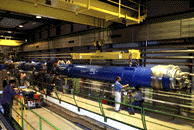

Pictorial representation of particle creation in the annihilation of an electron and a positron during a high energy collision.
The AdA (Anello di Accumulazione)
ring
One of the four LEP monorail trains: such trains circulate in the tunnel transporting goods and people.
The discovery of the W particle in the UA1 detector: a proton-antiproton collision produces a high transverse energy electron (arrowed)
CERN's 1984 Nobel prizewinners Carlo Rubbia (left) and Simon van der Meer
Overall view of the LHC experiments
Powerful superconducting magnets for CERN's next particle accelerator Large Hadron Collider (LHC)
The Accelerator Era
High
energy frontier
First, in the 1960s,
came the electron-positron collider. After Anderson's discovery
of the positron, physicists soon learned how to create large quantities
of positrons (the interaction of radiation with matter can produce an
electron and positron simultaneously). Several colliders were built in
Europe and the USA, and with them came many important discoveries about
the fundamental nature of matter and our universe.
The first electron-positron collider was the "Anello d'Accumulazione" (AdA), built by Bruno Touschek in Frascati (Rome) in 1960. The biggest of all is CERN's Large Electron Positron (LEP) collider, which began operation in the summer of 1989 with a collision energy of 91.2 GeV. The year 2000 will be LEP's last year of running, having now reached a massive collision energy of 204 GeV. The detectors around the LEP ring have been able to perform extremely precise experiments, testing and extending our knowledge of particles and their interactions.
In fact LEP will remain the largest circular electron-positron collider ever built: a property of electrons called "synchrotron radiation" makes it impossible to accelerate electrons to higher energies in a bigger circular collider. But plans are already afoot for the next generation of electron-positron collider - this time as linear colliders, where the electrons and positrons will collide head-on after being accelerated in a straight line over many, many kilometres...
The proton - antiproton collider, complementary to the studies and discoveries made with electron-positron colliders, unfortunately presented a much greater challenge. Since an antiproton (or proton) is almost 2000 times heavier than an antielectron (or electron), it takes a lot more energy to create them. It was also more difficult to collect antiprotons and store them long enough to make an antiproton beam circulate in a collider.
However, in the early 1980s, Simon van der Meer at CERN invented "stochastic cooling" - a technique that now made it possible to accumulate, concentrate and control antiproton beams. CERN's Super Proton Synchrotron (SPS) became a 300 GeV proton - antiproton collider, and in 1983 the UA1 experimental team, led by Carlo Rubbia, saw two new particles, the W boson and Z boson, being produced in the SPS collisions. Physicists had suspected for many years that these two bosons existed, and this exciting confirmation brought Rubbia and van der Meer the 1984 Nobel Prize for physics.
Today the most powerful proton - antiproton collider is at Fermilab, Chicago. With a collision energy of up to 1.8 TeV (that's 1800 GeV!), the Tevatron made news in 1995 with the discovery of the top quark.
And there's more... Since the early 1990s, CERN has been preparing for its next big collider: the Large Hadron Collider (LHC) will replace LEP in its underground tunnel and collide two proton beams at a record 14 TeV (14,000 GeV!).
But why proton-proton collisions, and not proton-antiprotons? Well, at such high energies as 14 TeV, proton-proton collisions and proton - antiproton collisions start to look pretty much the same. And as it's still so much easier to produce proton beams than antiproton beams, physicists have chosen to maximise the rate of collisions by just using two very dense proton beams - and thus to maximise the chances of a new discovery.
The LHC is now under construction at CERN, and four experiments ATLAS, CMS, LHCb and ALICE will be arranged around the collider ring.







